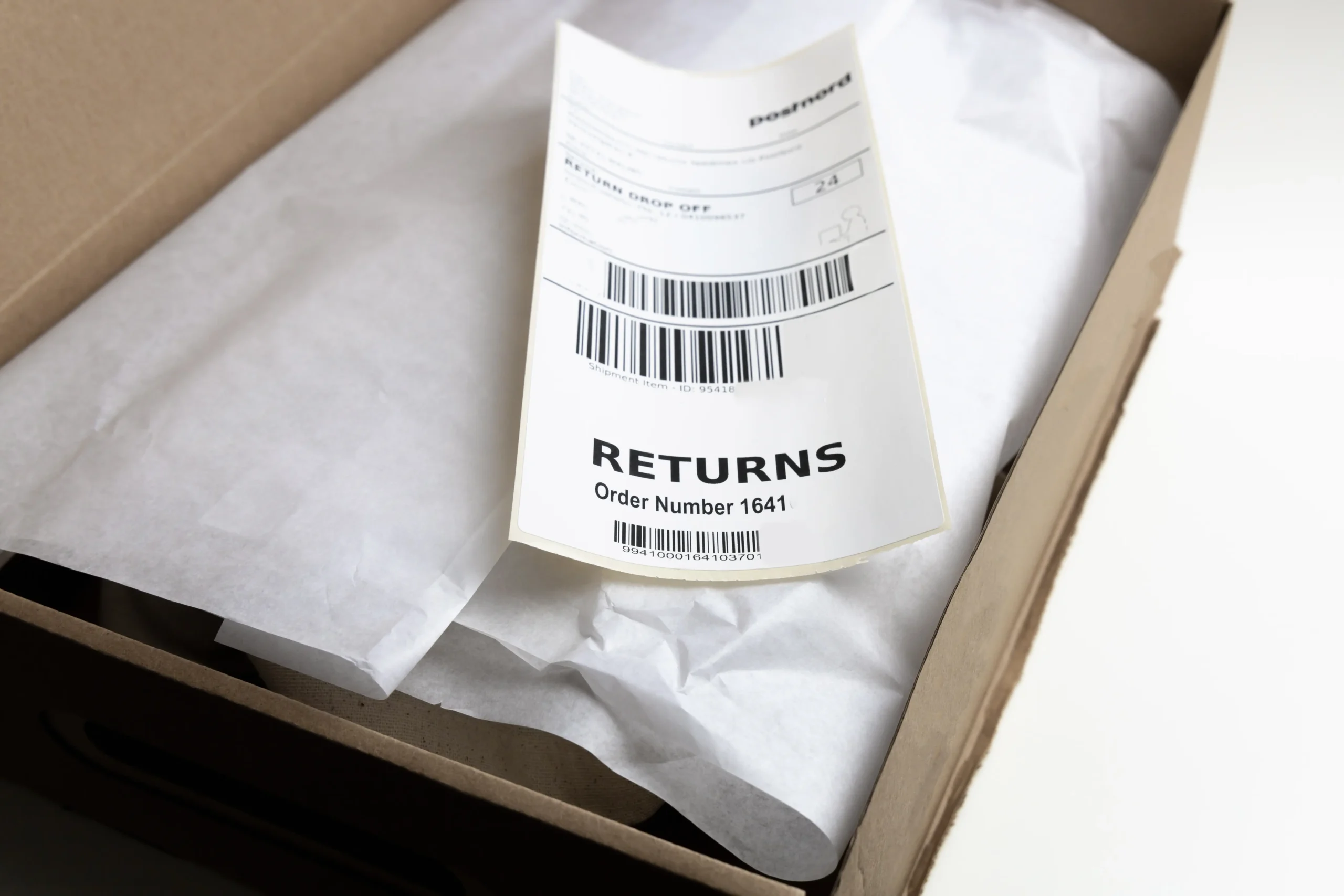What Is a “Lost Package” by USPS Standards?
USPS considers any mail not delivered by the expected delivery date a lost package.
Lost packages mean trouble for online businesses. If it happens often, it could hurt businesses, and upset customers might share their bad experiences online, damaging your brand reputation.
It’s important to understand who is responsible for lost packages. This ensures that the sender, carrier, and recipient know who is liable for covering the cost of lost packages. For example, if the sender did not properly package or label the product and it becomes undeliverable during transit, the sender should either send a replacement to the customer or provide a full refund.
Similarly, if the carrier cannot locate the package in their system, the sender must file a claim within a limited timeframe to recover the item’s value and shipping costs.
If the recipient provides an incorrect address to the sender and the carrier delivers the package to the wrong location, the recipient is not entitled to any reimbursements. However, some shippers may resend the order at their own expense to keep their customers happy.
In this article, you will learn about the responsibilities of the sender, recipient, and USPS in ensuring successful package delivery. Additionally, we will guide you on filing a USPS claim for lost or stolen packages so you can receive the full reimbursement.
USPS Policies on Lost Packages
USPS has a thorough investigation process that begins by checking packaging guidelines. USPS doesn’t take responsibility if the damage results from improper packaging. Additionally, if the package appears undamaged from the outside but is damaged inside, it is considered a packaging issue, and the claim can be denied.
For lost packages, the investigation determines when and where the package went missing.
Some of USPS’s mail services include insurance coverage, while some have insurance available for purchase. Below are the different USPS services and corresponding liability limits:
| Service Domestic | USPS Included Insurance Coverage |
|---|---|
| Priority Mail Express® | Up to $100 |
| Priority Mail® | Up to $100 |
| First-Class Mail® | Available for purchase |
| USPS Marketing Mail® | Available for purchase |
| USPS Retail Ground® | Available for purchase |
| Media Mail® | Available for purchase |
| Library Mail | Available for purchase |
| Parcel Select Lightweight® | Available for purchase |
| Bound Printed Matter | Available for purchase |
| Service International | USPS Included Insurance Coverage |
|---|---|
| Priority Mail Express International® | Up to $100 for documents Up to $200 for merchandise |
| Priority Mail International® | Up to $100 for documents Up to $200 for merchandise |
| First-Class Mail® | Available for purchase |
| USPS Marketing Mail® | Available for purchase |
| First-Class Mail International® | Available for purchase |
| First-Class Package International® | Available for purchase |
Learn more about shipping insurance through USPS on their site.
Responsibility of the Sender
Most senders claim that their responsibility for deliveries ends when they hand the parcel over to the carrier. But it’s important to remember that the actions taken before the package is handed off to the carrier will set the groundwork for whether the package makes it safely in the hands of the recipient. This means that it is critical for shippers to remember to properly package, mark, and label the shipment, as well as provide accurate and complete contact information.
Here are some actionable tips package senders should follow to avoid damaged or missing packages:
- Double-check to ensure that the name and address on the package match the order.
- Verify that all the necessary shipping labels are included and securely attached.
- Make sure to complete the “return to sender” section on the label in case the package can’t reach the recipient. If USPS cannot deliver the mail as addressed, it returns the mail item to the sender using the return address.
- Keep a record of the shipping information, including tracking information, invoices, and purchase orders to prove the value of the package and any supporting documentation. This will be helpful in filing a loss claim and tracking the package.
- Protect your high-value items against package theft or damage by adding insurance to the shipments. Carriers like USPS, FedEx, DHL, and UPS provide insurance coverage based on the service and level of protection you need. USPS Registered Mail® provides maximum security for valuable items with insurance coverage up to $50,000.
As a sender, it is important to file a claim with USPS if a parcel is lost or damaged during transit in order to make up for the cost of issuing a refund to the customer.
Responsibility of the Recipient
It is the recipient’s responsibility to ensure they are available to receive the package. For packages that require a signature, if no one is home to claim the delivery, the USPS driver will leave a note with the next scheduled delivery time and the local post office location where they can claim their package.
Please note that if the recipient provides an incorrect address, USPS does automatically perform address correction for a small fee:
- First-Class Mail—$0.08
- Other than First-Class Mail—$0.25
USPS Responsibility
The USPS is responsible for delivering packages to the correct address. They use scanners and tracking to monitor the package’s progress during delivery and share this information with both the sender and recipient.
If a package is sent that does not arrived within the standard delivery time, it may have gone missing. In this case, they should contact USPS customer service to request a missing mail search investigation.
Below are the different service types and guaranteed delivery times frames, if applicable, as well as when to submit a missing mail search request:
| Service | Standard Delivery Time | Guaranteed Delivery | Submit a Missing Mail Search Request |
|---|---|---|---|
| USPS Priority Mail Express® | 1-2 business days | Yes | Soon after the guaranteed delivery date and time is missed |
| First Class Mail® | 1-3 business days | No | After 7 days from the date of mailing |
| First Class Package Service® | 1-3 business days | No | After 7 days from the date of mailing |
| Priority Mail® | 1-3 business days | No | After 7 days from the date of mailing |
| USPS Retail Ground® | 2-8 business days | No | After 14 days from the date of mailing |
| Parcel Select Ground® | 2-8 business days | No | After 14 days from the date of mailing |
| Media Mail® | 2-8 business days | No | After 14 days from the date of mailing |
The USPS may locate the package or discover that it was lost or damaged. In either case, the responsibility shifts from the sender to the carrier. If this happens, the sender should file an insurance claim and request compensation from the carrier. Note that USPS won’t pay for an item more than its actual value.
While carrier investigations can be a hassle, shippers can speed up the claims process by keeping all necessary documentation readily available, including proof of value and photos of damaged packages.
Resolving Disputes
Once USPS receives the request, they will search for the missing package using the tracking number. If found, USPS will send it to the provided address. The sender will receive email updates as they gather more information.
Investigations in the claims process can be time-consuming for the carrier. Shippers can use the USPS claims dashboard to check the status of lost package claims.
Most disputes are resolved, and claim payments are issued within 7-10 business days.
If the sender’s claim is denied, they can appeal and submit additional evidence. However, if the sender is at fault, the claim will continue to be denied.
Recover Costs From Lost Packages with Sifted
With the frequency of lost packages, it becomes critical for shippers to stay on top of package status and file claims for reimbursement on damaged or missing packages. This is helpful for shippers and lessens the amount of upset customers.
Sifted Logistics Intelligence has helpful tools for shippers to automatically audit their carrier invoices for opportunities to file claims for lost or damaged packages. That means shippers have more time to focus on more important aspects of their business rather than chasing down lost packages.











